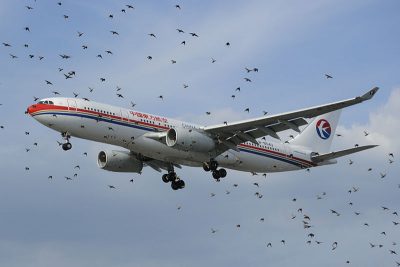
A new way to avoid bird-strikes? There are only a few things outside of an airplane that make a pilot nervous: electrical storms, wind shear and bird strikes top the list. Many techniques have been tried to keep those angry birds away None are full proof, but perhaps a recent novel invention will help.

There are few terms more appropriately coined than “bird-strike”. A bird-strike occurs when a bird in flight collides with a moving aircraft (https://wildlife.faa.gov/) . How often does this occur? According to The Bird Strike Committee there were 5,000 bird-strikes to U.S. Air Force airplanes alone in 2010. If you add in civilian aircraft the number increases by almost 9,000 and that is over just one year. The Bird Strike Committee was formed in 1991 to help facilitate the exchange of information regarding bird and other wildlife strikes (e.g. hitting a deer on takeoff or landing).
The Critical Period


The most serious time a bird-strike can occur is during takeoff and climb out. I blogged earlier on my “record setting” bird strike during a touch and go in the early 1990’s (https://doctoraviation.com/record-bird-strike/). The most famous bird strike of all time occurred to US Airways Flight 1549 in 2009, when Captain Sully Sullenberger was forced to make an emergency landing on the Hudson River. Sully’s plane encountered a flock of birds shortly after takeoff, again that critical period.
The Boeing Report
One of the best website on the subject is done by Boeing (https://www.boeing.com/commercial/aeromagazine/articles/2011_q3/4/). The website contains great statistics (e.g. the first bird-strike occurred in 1905, to the Wright Brothers). There are photographs of damaged aircraft parts and an illustrative picture on what portions of the aircraft are most susceptible to strike. The dollar damage is significant and more so the loss of life.

Boeing lists several techniques in order to prevent bird-strikes. Some are very practical such as delaying takeoff if heavy bird activity is reported. Some include trying laser and noise makers near the runway. These have had limited success.
A Very Novel Approach

I was recently listening to the Aviation Report hosted by Jay Ratliff on WLW (https://700wlw.iheart.com/featured/aviation-blog-jay-ratliff/) . He reported a “Sponge Bob” type of technique being tested in France. In a series of tests over a five week period, a set of human eyes were projected on a small screen near the runway. It is not actually Sponge Bob, but the device projected big eyes much like the cartoon character. The eyes grow larger, giving the sensation of them growing closer. The raptor, a notorious offender (or participant) when it comes to bird-strikes seemed to be held at bay by the eyes. Smaller birds did not seem to be affected. While further testing is required, the device has the potential to be an incredibly simple solution to a big bird problem. (https://www.gatechecked.com/scientists-able-to-scare-away-birds-around-airport-with-googly-eyes-573)
